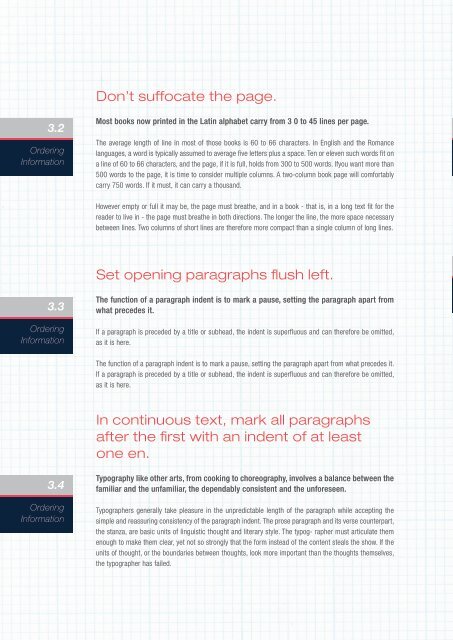5 Trick Pony Brand Guidelines v3
You also want an ePaper? Increase the reach of your titles
YUMPU automatically turns print PDFs into web optimized ePapers that Google loves.
Don’t suffocate the page.<br />
3.2<br />
Ordering<br />
Information<br />
Most books now printed in the Latin alphabet carry from 3 0 to 45 lines per page.<br />
The average length of line in most of those books is 60 to 66 characters. In English and the Romance<br />
languages, a word is typically assumed to average five letters plus a space. Ten or eleven such words fit on<br />
a line of 60 to 66 characters, and the page, if it is full, holds from 300 to 500 words. Ifyou want more than<br />
500 words to the page, it is time to consider multiple columns. A two-column book page will comfortably<br />
carry 750 words. If it must, it can carry a thousand.<br />
However empty or full it may be, the page must breathe, and in a book - that is, in a long text fit for the<br />
reader to live in - the page must breathe in both directions. The longer the line, the more space necessary<br />
between lines. Two columns of short lines are therefore more compact than a single column of long lines.<br />
Set opening paragraphs flush left.<br />
3.3<br />
Ordering<br />
Information<br />
The function of a paragraph indent is to mark a pause, setting the paragraph apart from<br />
what precedes it.<br />
If a paragraph is preceded by a title or subhead, the indent is superfluous and can therefore be omitted,<br />
as it is here.<br />
The function of a paragraph indent is to mark a pause, setting the paragraph apart from what precedes it.<br />
If a paragraph is preceded by a title or subhead, the indent is superfluous and can therefore be omitted,<br />
as it is here.<br />
In continuous text, mark all paragraphs<br />
after the first with an indent of at least<br />
one en.<br />
3.4<br />
Ordering<br />
Information<br />
Typography like other arts, from cooking to choreography, involves a balance between the<br />
familiar and the unfamiliar, the dependably consistent and the unforeseen.<br />
Typographers generally take pleasure in the unpredictable length of the paragraph while accepting the<br />
simple and reassuring consistency of the paragraph indent. The prose paragraph and its verse counterpart,<br />
the stanza, are basic units of linguistic thought and literary style. The typog- rapher must articulate them<br />
enough to make them clear, yet not so strongly that the form instead of the content steals the show. If the<br />
units of thought, or the boundaries between thoughts, look more important than the thoughts themselves,<br />
the typographer has failed.





